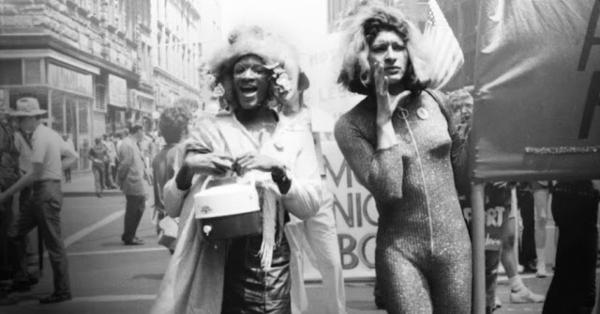Marsha P. Johnson, the trans activist who inspired the celebration of LGBT pride
Stonewall veteran, interpreter, beggar, prostitute and model of Andy Warhol, this is how some define Marsha P. Johnson from the beginning of her fight from that June 28, 1969 during the Stonewall riots . That night, in the bar that belonged to the mafia, located in the Greenwich Village neighborhood of New York, gays, lesbians, trans, bisexuals and Drag Queens, were victims of a raid. From then on, after having confronted the police and taking part in the demonstrations that arose in the following days, Marsha became a reference in the LGBT liberation movement.
“Marsha Johnson, queen of the Village. One of the greats, she is one of the bravest people in the world. She always wanted to cross-dress and never had the courage. She is one of those who had courage and I congratulate her, I congratulate her, or whatever she wants to be. And not only that, she doesn't care if she wears men's or women's clothes, does she? She is free,” a man is heard saying as he hugs her in a recording featured in the 2017 David France-directed Netflix documentary The Death and Life of Marsha P. Johnson. "Marsha Johnson is our queen forever," he concluded.
She was born on August 24, 1945 in New Jersey, United States. At the age of five she began to wear dresses, but she stopped wearing them for a while because she received teasing and aggression from her classmates. During her youth, she moved to New York and became a Drag Queen, but since she had no money, she used clothes and accessories that she found on the street or donated to her. It was from that moment on that she began to call herself Marsha P. Johnson.
// International LGBT+ Pride Day: why it is commemorated every June 28

In an interview she gave four days before her death, Marsha clarified what her P stood for in her name: "Pay it no mind." "They call me Marsha 'Pay it no mind' Johnson because I try to pay for a lot of little things that happen to me in life, absolutely not caring." Furthermore, that same day, she claimed that she was arrested many times for prostitution and that the police treated her as if she were, in her words, the greatest murderer in the world.
In 1970, together with her friend Sylvia Rivera , a trans woman, also a veteran of Stonewall and the LGBT liberation movement, they founded STAR (Street Transvestite Action Revolutionaries - Travestis Callejeras de Acción Revolucionaria) a space for those people in the community who had no roof over their heads. or access to food or clothing. Both financed the organization with money from their own pockets that they obtained from prostitution.
“She and I were liberators. Street people and Drag Queens were the vanguard of the movement. We went to the front and fought with the police. We didn't care if they hit us on the head," Sylvia said in a video from 1994. But despite leading the fight for LGBT rights, the Drag Queens were denied and felt left out by the community itself in those early days. revolution steps. “If it wasn't for a drag queen, there would be no liberation movement,” said Rivera, who for years fought for minority rights. In fact, Marsha had spoken about it: “In 1973, Sylvia Rivera and I were told that we could lead the Gay Pride March, the transvestites leading the march. Honey, the chickens put all the drag queens in hiding in the back. That was not right. They do not care if you were at the beginning of the gay movement manifesting cross-dressing with them, ”she assured.
Along her journey, she was also photographed by Andy Warhol and her portraits became works in the Ladies and Gentleman collection in 1975. The plastic artist had taken photos of trans women and African American and Latin Drag Queens. In New York.
In the late eighties, she joined ACT UP , an organization that sought to raise awareness about AIDS and defend the victims of this disease, proposing laws and actions that favored those who suffered from it. In the last interview she gave, Marsha stated that she had been HIV positive for two years.
Finally, after fighting for years for LGBT rights, on July 6, 1992, she was found dead , at the age of 46, in the Hudson River , on the Christopher Street pier, a few blocks from Stonewall . Although the main cause of her death was due to drowning and the police claimed that it was a suicide, a possible homicide is not ruled out. Even the community doubted from the start that Marsha had taken her own life, and they marched on Christopher Street to demand justice. Hate crime reported.
// Tanu Pesoa: “I am not like the stereotypical images of the transgender male, but I am a man”
The documentaries that record the life, the fight for LGBT rights and the death of Marsha
Pay It No Mind, the documentary directed by Michael Kasino and Richard Morrison, premiered in 2012. Through the testimonies of Marsha's friends and the last interview she conducted days before her death, her passage through life is reconstructed and the path he traveled as an activist and reference for the LGBT community.
On the other hand, in 2017, Netflix released The Death and Life of Marsha P. Johnson, directed by her friend David France. The film, which focuses on the investigation of Marsha's death by Victoria Cruz, an activist and member, at the time, of the New York LGBT Anti-Violence Project, also details the journey of Sylvia Rivera.




